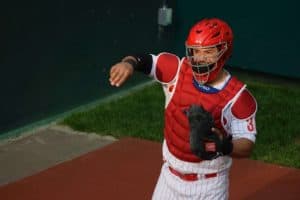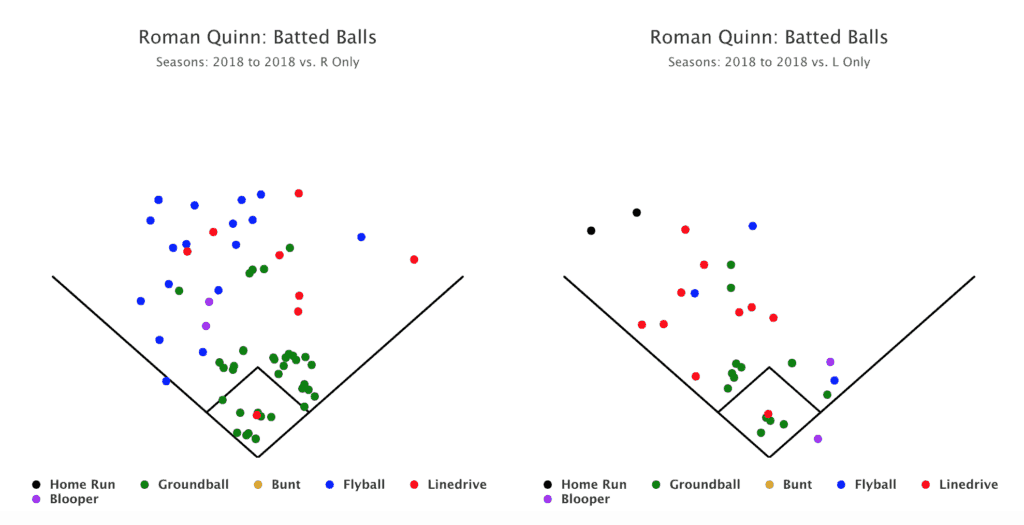

Jorge Alfaro could finally be ready to take the next step in his career (Ian D’Andrea, Wikicommons)
Aaron Nola had a spectacular season in 2018, finishing the season as a National League MVP and Cy Young candidate. With a 2.27 ERA and a 17-6 record, Nola cemented himself as the Phillies ace for years to come. Now that Nola has reached stardom, a new question emerges: who will be the next Phillies player to break-out? Obviously, predicting a player to have a season like Nola’s would be unreasonable. However, expecting a young player to have a productive season shouldn’t be a surprise, especially as the team continues its growth and makes its way towards earning a playoff spot.
While there are a number of young players on the Phillies that could conceivably experience an uptick in performance, three come to mind: Roman Quinn, Nick Pivetta and Jorge Alfaro. All three should all be in line for regularplaying time, and if the trio is able to correct the issues that plagued them last season, they should become valuable pieces of the next great Phillies team.
Roman Quinn
Roman Quinn has already had a long career in the Phillies organization, being drafted in the second round in 2011. Quinn looks ready to make an impact, mainly with his fantastic speed.
Quinn first appeared in the majors in 2016, and again in 2018. In total, he’s seen action in 65 games. In that time, Quinn has stolen 15 bases. Using Baseball Reference‘s 162 games average formula (what a player would average over a full season), Quinn would be averaging 37 stolen bases, which would be tops on the Phillies by far (Quinn stole 10 in just 50 games this past year). Baseball Savant‘s statcast shows that in 2018, Quinn had a sprint speed of 30.2. That put him third in all of baseball. It’s also an improvement from the 30.0 sprint speed he had in 2016. Quinn could very well usurp the leadoff spot from Cesar Hernandez.
However, in order to secure a starting role and not be used for platooning, Quinn will need to improve against right-handed pitching. Despite being a switch hitter, Quinn hit .239 in 100 plate appearances against right-handers in 2018, while hitting .302 in 43 plate appearances against left-handed pitching. The differences in Quinn’s batted balls against left-handers and right-handers were stark. While the sample size is small, it should not be overlooked:


Source: Fangraphs
Besides his on-field performance, the main focus for Quinn should be just to stay healthy, as he has been plagued by the injury bug ever since being drafted. As Jim Salisbury of NBC Sports Philadelphia reminded us, Quinn has had a torn left Achilles tendon, a concussion, a torn left quadriceps and a strained elbow ligament. That was all mentioned in an article back in May, which was about Quinn requiring surgery for a torn ligament in his right middle finger, which caused him to miss an extended amount of time.
That is no doubt Quinn’s main challenge. Fair or not, it could be assumed that the team will be wary of trusting a starting role to a player who has missed so much time over the past few seasons. But if Quinn is healthy, it feels like a safe bet he will be front-and-center in the Phillies plans in 2019.
Nick Pivetta
Nick Pivetta, acquired in the 2015 Jonathon Papelbon trade with the Washington Nationals, has started 58 games since the start of the 2017 season. While his statistics may not jump off the page, there are a number of signs that signal more improvement may be on the way. The 25-year-old has put up a 15-24 record with a 5.33 ERA in his two seasons in the majors. However, Pivetta greatly improved from 2017 to 2018, lowering his ERA from 6.07 to 4.77 and his FIP from 4.87 to 3.80, while increasing his SO/9 from 9.5 to 10.3. His stuff is real. Pivetta managed to increase the swing-and-miss percentage on three of his pitches from 2017 to 2018:
Source: Baseball Savant
In order to truly take that leap, Pivetta needs to make some adjustments, one of which would be lowering his home runs allowed. He’s allowed 49 home runs in 297.0 innings pitched over his two years. In 2018, Pivetta allowed 24 home runs, which when ranked among all qualifiers in baseball, would put him in the middle of the pack. While not terrible, it’s wouldn’t do Pivetta any harm in trying to bring down that number, especially when you consider the home runs seemed to plague him in high-leverage situations.
During Spring Training, Pivetta’s time could be well spent working on pitching to lineups the second and third times through, an area he struggles. In 2018, Pivetta’s ERA during the first through third innings was 4.00. He held batters in those innings to an average of .244 and struck out 112. In the fourth through sixth innings, Pivetta’s stats took a drastic turn as his ERA bumped up to 5.71. The average of batters versus Pivetta in those innings also bumps up to .282, and the number of strikeouts he has lowers to 65. If Pivetta can go longer into games without fading, he can turn into a reliable middle-of-the-rotation power pitcher.
Jorge Alfaro
Even though he’s appeared in the majors every year dating back to 2016, 2018 was Jorge Alfaro’s first full season in the majors. In 108 games, Alfaro hit 10 home runs with 37 RBIs and a .262 batting average. However, Alfaro’s playing time was altered by the trade of Wilson Ramos in July. If Ramos isn’t retained, Alfaro figures to get an overwhelming majority of the starts behind the plate.
One of Alfaro’s greatest and most praised strengths is his arm. This past March, MLB.com created a new statistic called catcher pop times, where the statistic calculates how much time it takes for the catcher to throw the ball during a stolen base attempt. When throwing to second base, Alfaro had a pop time of 1.94, which ranked third in baseball among all qualifying catchers. Alfaro’s arm rated as a 90.8, which was tops in the rankings.
While Alfaro’s pitch framing has drastically improved, he also allowed 10 passed balls last season, which ranked first in the National League. Alfaro also ranked first in the National League in errors at catcher with 11. He still isn’t a finished product behind the plate.
Going back to Baseball Reference‘s 162 game formula, Alfaro would be averaging about 17 home runs in a full season. Having around that should likely be the goal for Alfaro going into next season, as his power was highly valued by the Phillies when they acquired him back in 2015. Alfaro definitely has the potential to be a power hitter. As MLB.com explains, exit velocity (the speed of the ball after being hit) can be a helpful way of trying to determine a batter’s future performance. According to Baseball Savant, Alfaro’s exit velocity in 2018 was 91.6, while the league average was 87.3. As the chart below shows, most of Alfaro’s batted balls have had an exit velocity between 80 and 110, the most being 105:
Source: Baseball Savant
One major aspect of Alfaro’s hitting that needs to be improved upon is his strikeouts. Last season, Alfaro had 138 strikeouts, which was the third most for a catcher in Major League Baseball. Alfaro was behind Texas’ Robinson Chirinos (140) and Seattle’s Mike Zunino (150). Once again, a full season average for Alfaro would be about 200 strikeouts. Alfaro also had just 18 walks, which when compared to other catchers around the league ranks near the bottom. If Alfaro can make headway in those areas, he should become a daily contributor for the offense.